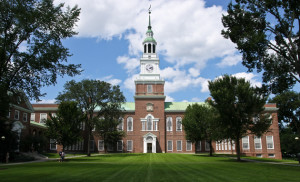The state of the liberal arts is near the top of the list of recurring themes in today’s chatter on higher education. It has become increasingly clear that complexity in white-collar industries, matched with the recent economic downturn, have made employers less willing to take a chance on graduates without practical skills. America’s universities are left to adapt their curricula to employer needs or risk gradually diminishing their ability to match graduates with top recruiters, a major selling-point of any college brand. The dilemma is shared amongst schools that identify as liberal arts colleges and research universities that nonetheless maintain liberal arts programs at the heart of their undergraduate curricula.
While the trend toward practical skills has provided an opening for the occasional STEM champion to proclaim the death of the liberal arts, most voices in academia still believe that the liberal ideal is worth preserving. “Successful careers require critical thinking, teamwork, sensitivity to cultural, demographic, economic and societal differences and political perspectives. A liberal arts education provides this grounding,” offered Oregon State University President Edward J. Ray in 2013, providing a succinct summary of the conventional wisdom.
Having agreed that traditional education remains as essential as ever, professors and faculty are tackling the challenge of retooling courses and extracurriculars to develop tangible skills on top of knowledge and perspective. President Phil Hanlon ’77 assumed office with full recognition of this growing demand, and has been describing a broad vision for academic reform since his first day on the job. “To instill wisdom in our students, we must fully-harness the power of experiential learning—learning by doing,” he proposed in his inaugural address on September 20, 2013. President Hanlon has repeatedly touted the concept of experiential learning as the best solution for Dartmouth’s liberal arts predicament. But with no major initiative announced regarding experiential learning after Hanlon’s first year, and especially in the wake of Moving Dartmouth Forward, one must look for the hallmarks of Hanlon’s vision in specific courses and activities.
The full development of President Hanlon’s experiential learning vision will require professors to create opportunities for hands-on learning within the regular curriculum. The Review reached out to Mr. Hanlon for his thoughts on this crucial but undeveloped part of his academic plan. He spent the large part of the conversation highlighting a litany of courses that have always incorporated student activity, mostly in the engineering and social sciences departments. “[Experiential learning] comes in many types; one is courses where you build or design something,” he described in specific reference to ENGS 21 and ENGS 12, Dartmouth’s renowned introductory engineering courses in which students focus on basic mechanical engineering and design projects. For a more ambitious example within the Engineering department Mr. Hanlon cited ENGS 71, an advanced course on structural analysis taught by Professor Vicki May in which students design and construct a full-scale, functional structure for an organization in the Upper Valley community. To touch on experiential learning development outside of the naturally practical engines department, he brought up ENVS 50, “a course on environmental problem analysis where they actually work with a company in the Upper Valley that needs consulting help,” and Professor Charles Wheelan’s nascent Public Policy 85 course which has prepared students to present policy recommendations to government panels in India and Northern Ireland. And finally, he included a reference to hands-on learning in the arts, citing Art History courses that allow students to design temporary exhibitions in Dartmouth’s Hood Museum.
President Hanlon went on to exclaim the growing importance of experiential learning as a value proposition for the College. “We’re on the cusp of the point where knowledge is ultimately going to be a free public good,” he said in reference to the popularization of publicly archived university lectures and participatory online classes, know as Massively Open Online Courses or “MOOCs”. He envisioned a quickly-arriving world in which any consumer could freely access the information being taught at Dartmouth and elsewhere, and used that scenario as a pretext for why the College must offer students more than “book learning” alone. “Think with me for a moment about developing the confidence to innovate and take risks. You’re not going to do that by sitting in a chair and having someone talk to you. You’re going to do that by trying things, by failing, by being coached and trying again.” By Mr. Hanlon’s reckoning, a shift toward this mode of learning would help ensure that prospective students continue to see the premium they would pay for a Dartmouth education as a worthy investment.
The fact that President Hanlon intends to weave experiential learning into the fabric of the College rather than promote hands-on learning through a central department makes it harder to define and measure. But it is also a reassuring sign that he has much more than PR in mind when he touts experiential learning as the key to Dartmouth’s future. A gradual increase in opportunities for students to learn by doing, spread throughout every academic department and extracurricular realm, will require more patience to implement than the top-down programs at our peer institutions. But if President Hanlon, the administration, and faculty manage to stay the course with experienced new-hires, curricular balance, and a way to gauge our progress, Dartmouth students stand to benefit immeasurably from the update. Defenders of the liberal arts should applaud this effort, which upholds the value of traditional knowledge by developing students’ ability to bring that knowledge to bear in today’s dynamic world.


Be the first to comment on "Let’s Put the Liberal Arts to Work"